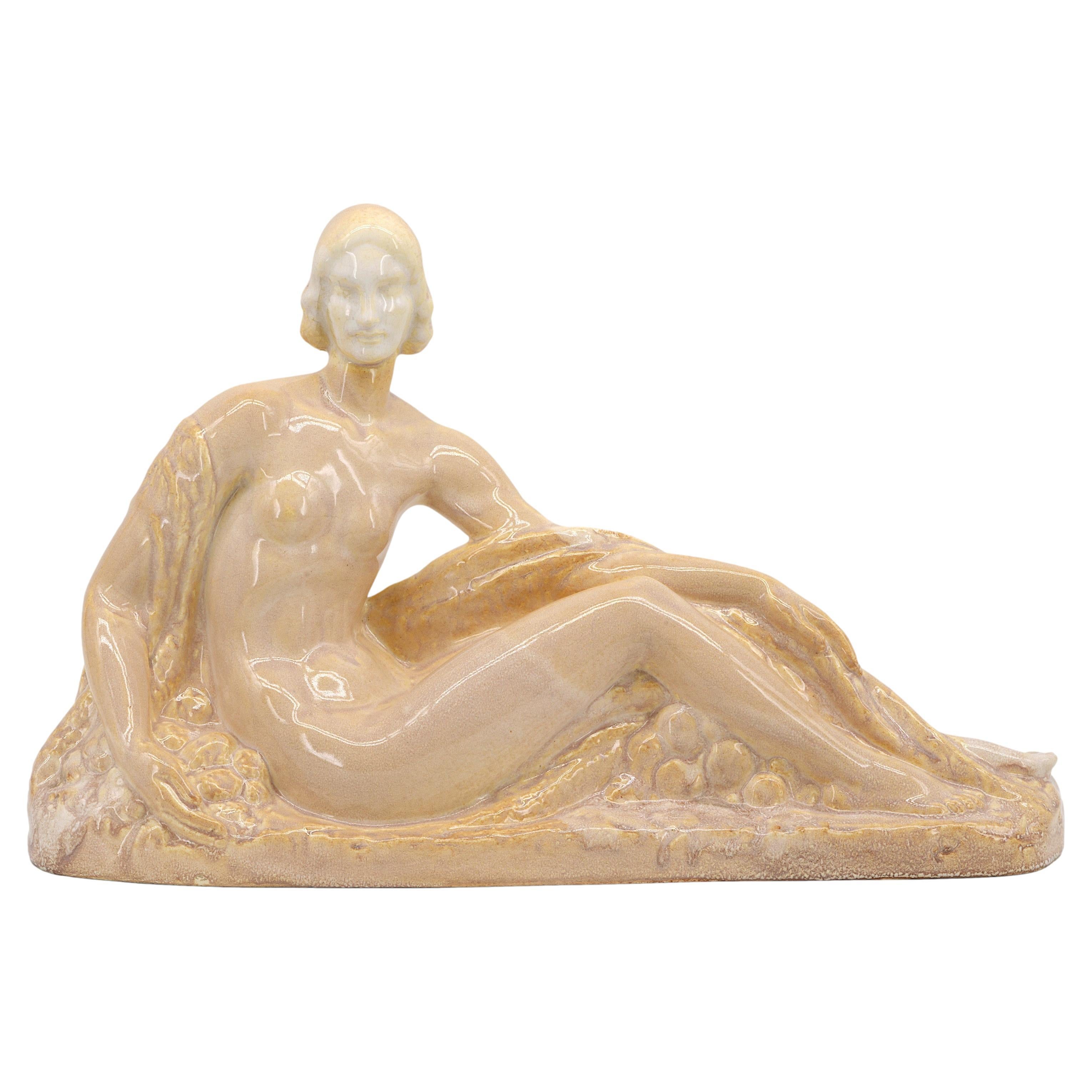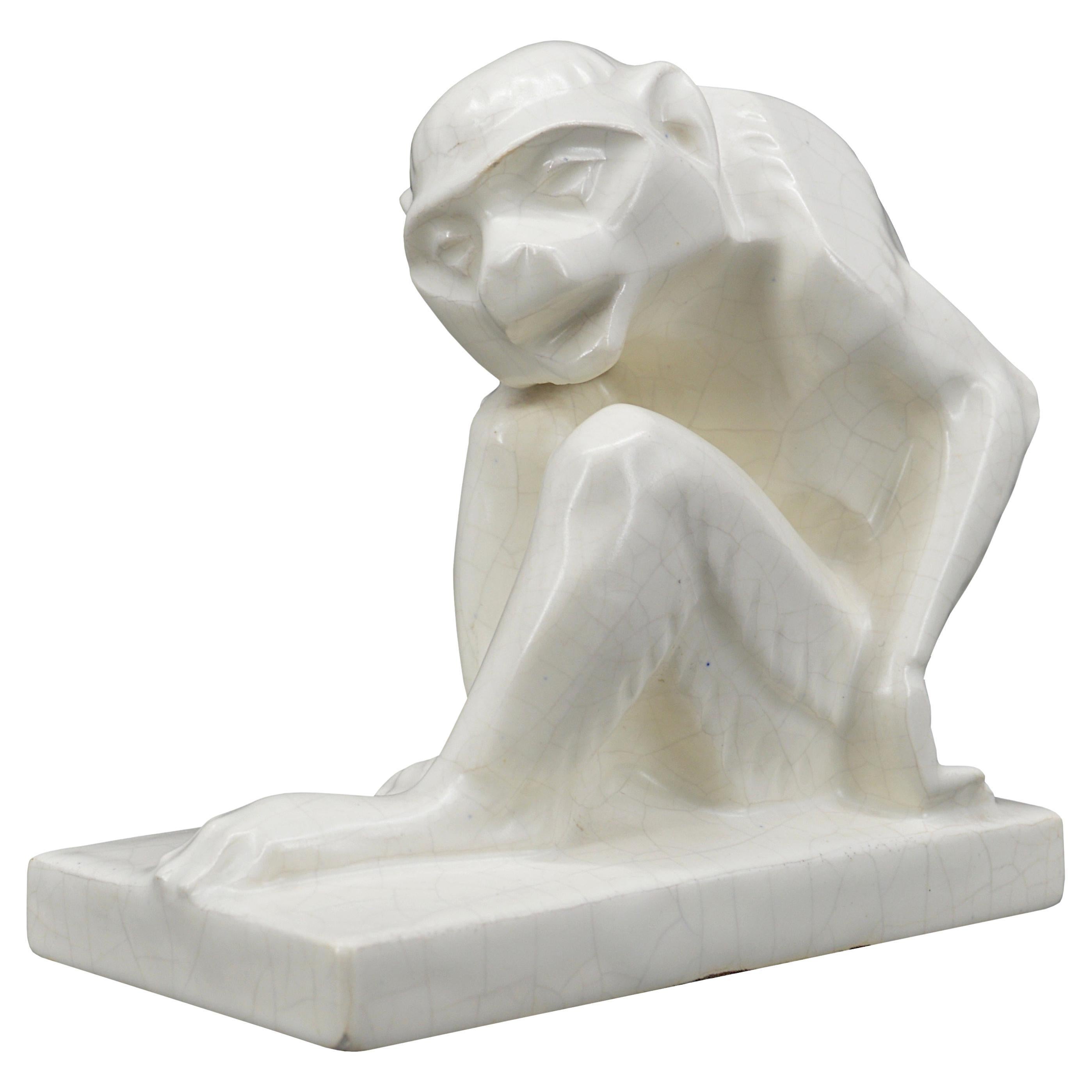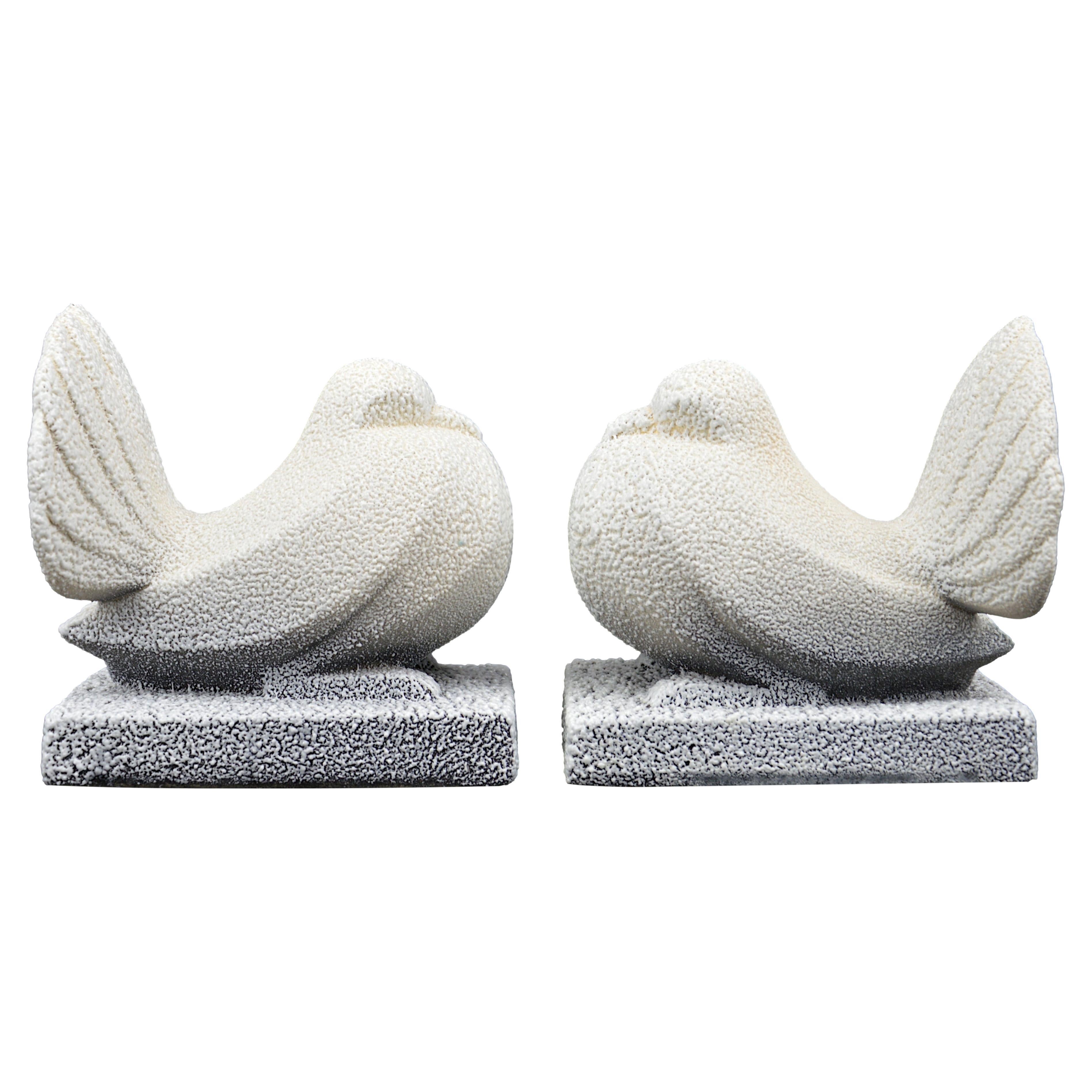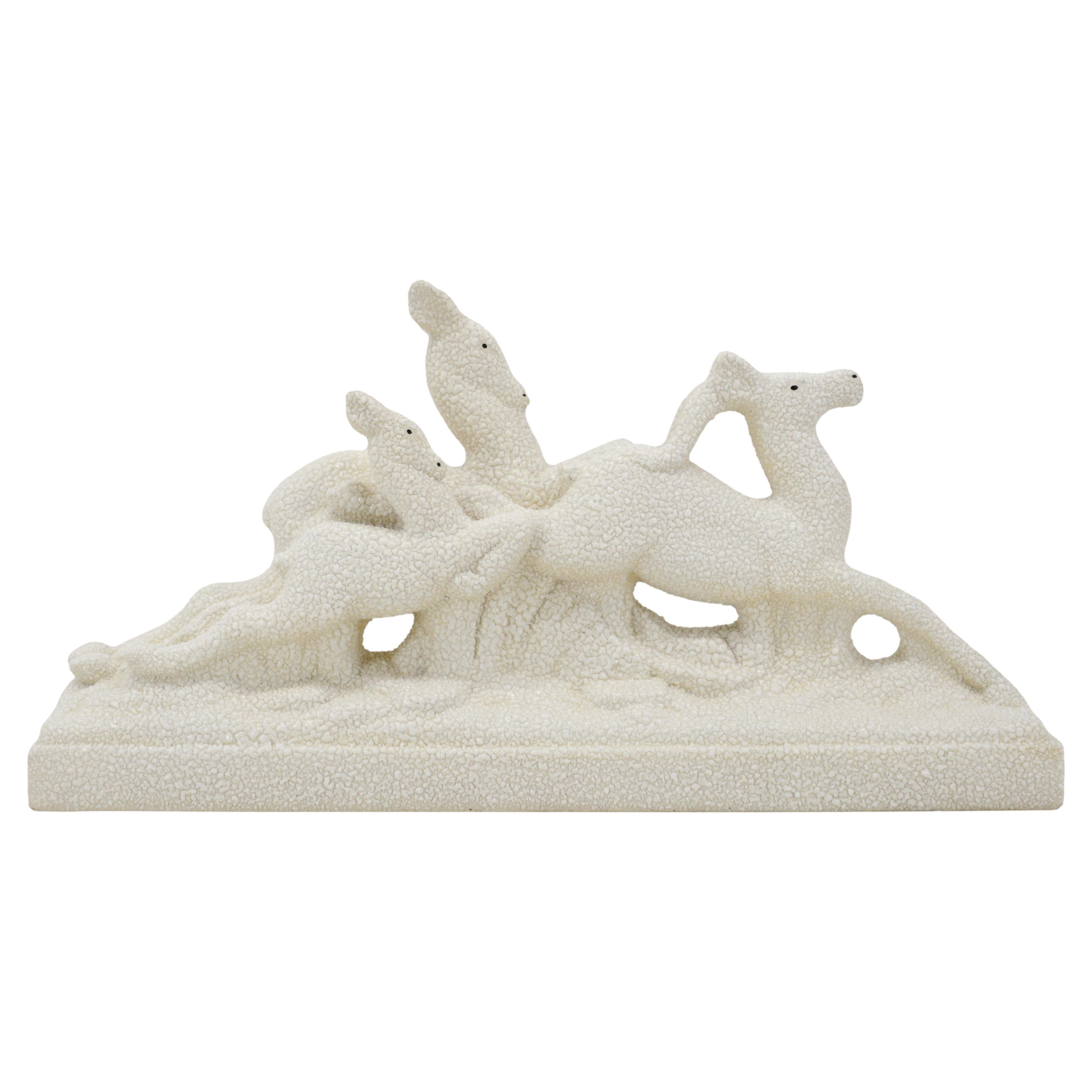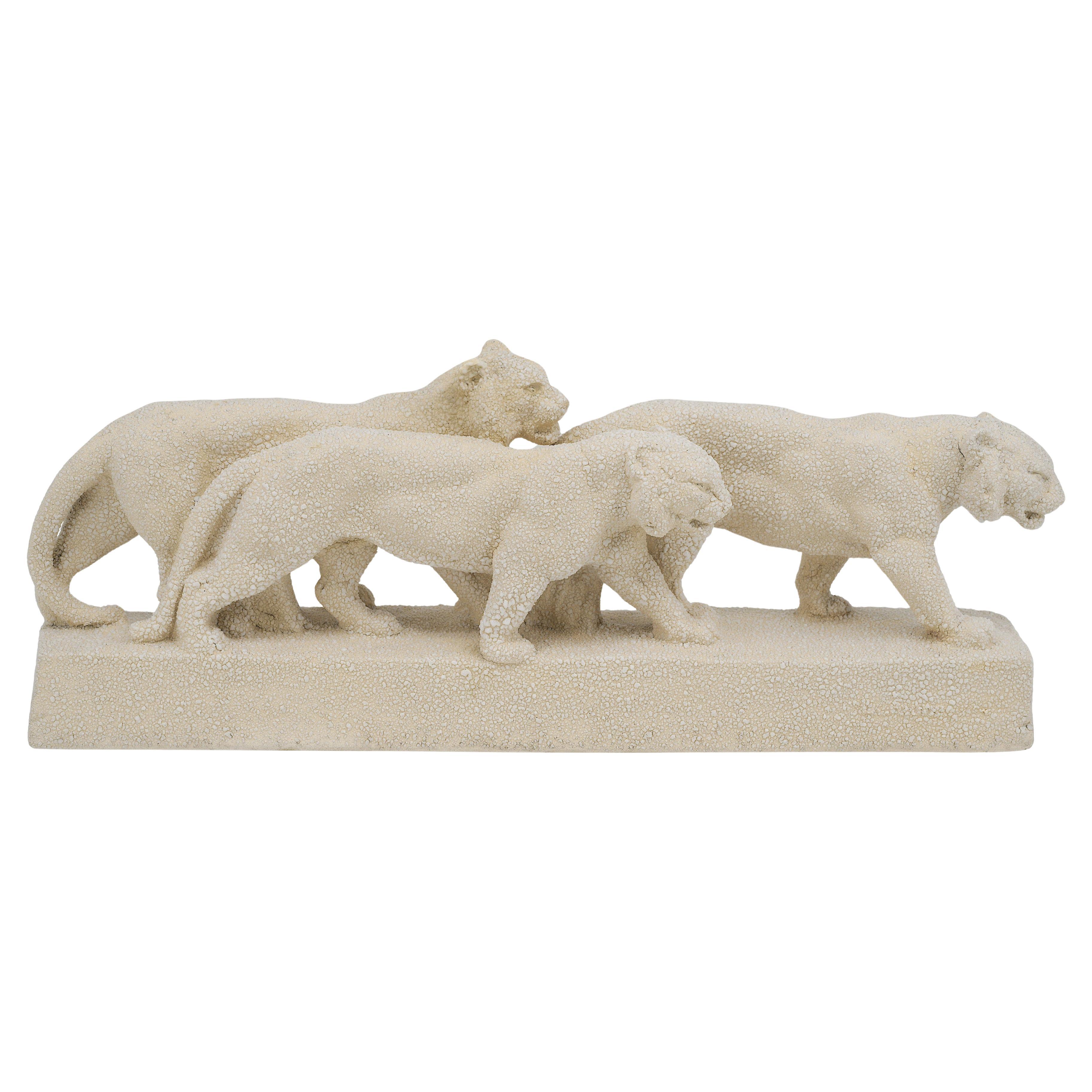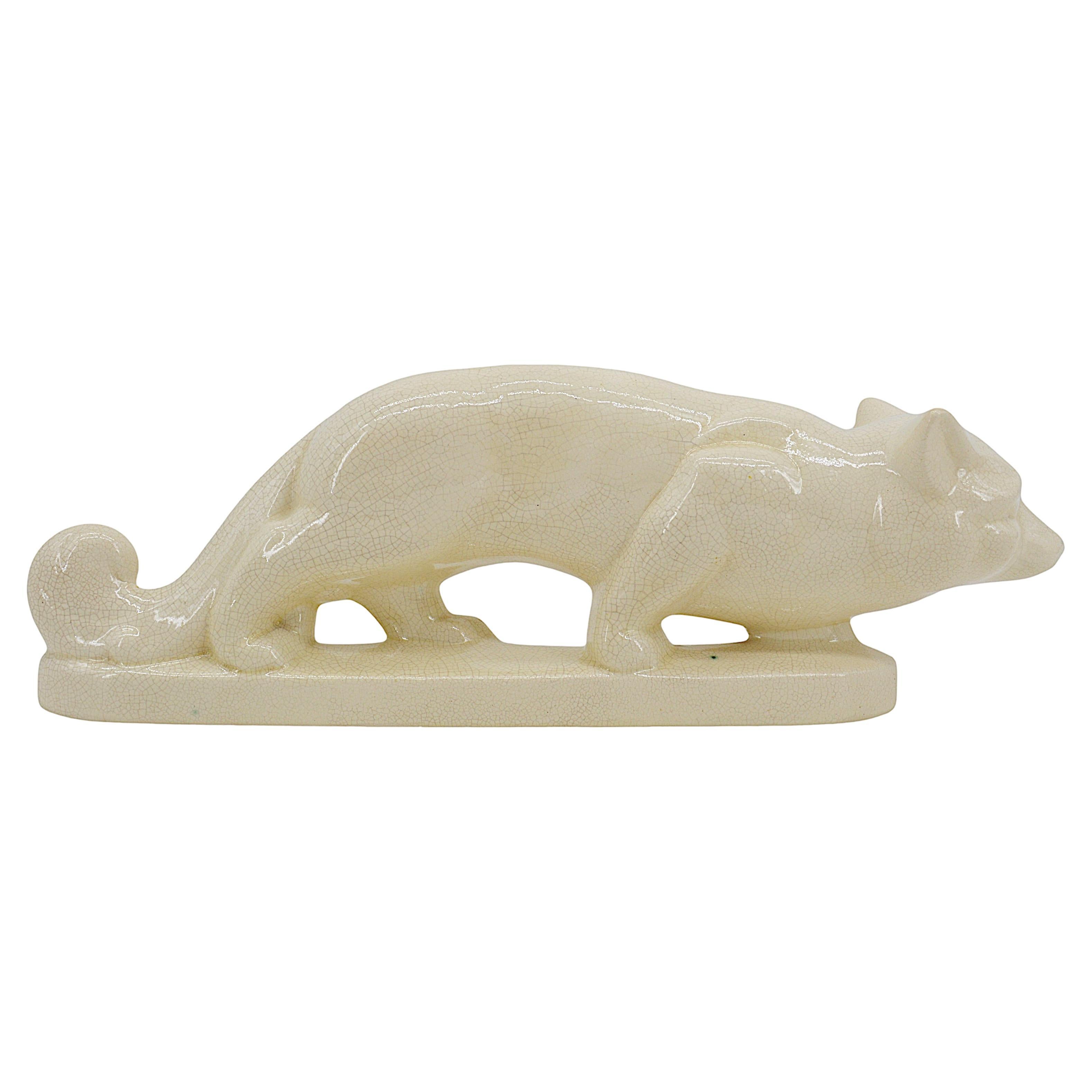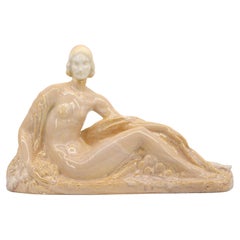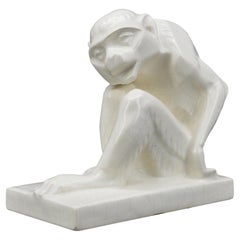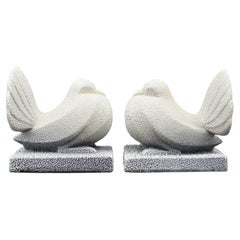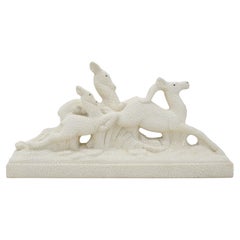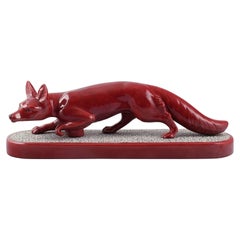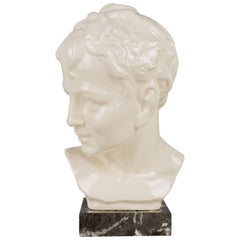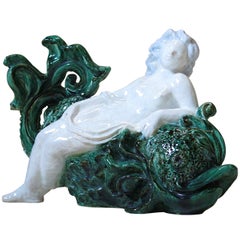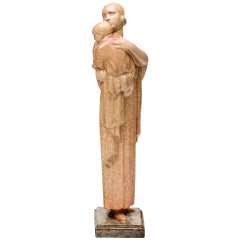Items Similar to French Art Deco Ceramic Fox by Gustave Gillot for Odyv, 1920
Want more images or videos?
Request additional images or videos from the seller
1 of 9
French Art Deco Ceramic Fox by Gustave Gillot for Odyv, 1920
About the Item
French Art Deco ceramic fox sculpture by Gustave Gillot (1888-1965) for Berlot-Mussier), France, 1920s. Illustration of the fable "The Fox and the Grape" by Jean de La Fontaine. Height: 8.7"(22cm), Width : 18.9"(48cm), Depth: 4.3"(11cm). Marked "Odyv" under the base and "G. Gillot" on the base (see photos). Gustave Gillot was a pupil in Paris of the great Sculptor Paul Landowski (Grand Prix de Rome for sculpture in 1900). He has exhibited at the Salon des Artistes Français since 1913, and at other important Parisian salons.
- Creator:ODYV (Manufacturer),Gustave Gillot (Sculptor)
- Dimensions:Height: 8.67 in (22 cm)Width: 18.9 in (48 cm)Depth: 4.34 in (11 cm)
- Style:Art Deco (Of the Period)
- Materials and Techniques:
- Place of Origin:
- Period:
- Date of Manufacture:1920
- Condition:
- Seller Location:Saint-Amans-des-Cots, FR
- Reference Number:1stDibs: LU2312342094122
About the Seller
5.0
Platinum Seller
Premium sellers with a 4.7+ rating and 24-hour response times
Established in 2003
1stDibs seller since 2016
477 sales on 1stDibs
Typical response time: 1 hour
- ShippingRetrieving quote...Shipping from: Saint-Amans-des-Cots, France
- Return Policy
Authenticity Guarantee
In the unlikely event there’s an issue with an item’s authenticity, contact us within 1 year for a full refund. DetailsMoney-Back Guarantee
If your item is not as described, is damaged in transit, or does not arrive, contact us within 7 days for a full refund. Details24-Hour Cancellation
You have a 24-hour grace period in which to reconsider your purchase, with no questions asked.Vetted Professional Sellers
Our world-class sellers must adhere to strict standards for service and quality, maintaining the integrity of our listings.Price-Match Guarantee
If you find that a seller listed the same item for a lower price elsewhere, we’ll match it.Trusted Global Delivery
Our best-in-class carrier network provides specialized shipping options worldwide, including custom delivery.More From This Seller
View AllFrench Art Deco Ceramic Lady by ODYV, 1920
By ODYV
Located in Saint-Amans-des-Cots, FR
French Art Deco ceramic sculpture by BERLOT-MUSSIER (Vierzon), France, 1920s. Young Lady among flowers in the style of René Buthaud in colored crackle glaze ceramic. Measures: Height...
Category
Vintage 1920s French Art Deco Figurative Sculptures
Materials
Ceramic
ODYV French Art Deco Ceramic Monkey, 1920
By ODYV
Located in Saint-Amans-des-Cots, FR
This French Art Deco crackle glaze ceramic sculpture by BERLOT-MUSSIER, created in the 1920s in Vierzon, France, features a monkey in a playful and stylized pose. The sculpture stand...
Category
Vintage 1920s French Art Deco Animal Sculptures
Materials
Ceramic
ODYV French Art Deco Ceramic Pigeons Bookends, 1920
By ODYV
Located in Saint-Amans-des-Cots, FR
French Art Deco bookends by Odyv, France, 1920s. Two pigeons face to face. Measures: Each - Height: 5.5"(14cm), Width : 5.5"(14cm), Depth: 4.3"(11cm).
The ODYV brand is a creation o...
Category
Vintage 1920s French Art Deco Animal Sculptures
Materials
Ceramic
Berlot-Mussier ODYV French Art Deco Antelope Family, 1920
By ODYV
Located in Saint-Amans-des-Cots, FR
French Art Deco ceramic sculpture by Berlot-Mussier (Vierzon, 1929-1939), France, 1920s. Antelope Family. Measures: height: 8.3"(25.7cm), width : 20.5"(50cm), depth: 3.9"(10cm). Mark...
Category
Vintage 1920s Art Deco Animal Sculptures
Materials
Ceramic
French Art Deco Ceramic Tigers, 1920
By ODYV
Located in Saint-Amans-des-Cots, FR
French Art Deco ceramic sculpture by Odette Berlot & Yvonne Mussier, France, 1920s. Three tigers. Measures: height: 8.3"(21cm), width : 20.5"(52cm), depth: 3.9"(10cm). Marked "Odyv 1...
Category
Vintage 1920s French Art Deco Animal Sculptures
Materials
Ceramic
Louis Fontinelle French Art Deco Crackle Glaze Ceramic Fox, 1920
By Louis Fontinelle
Located in Saint-Amans-des-Cots, FR
French Art Deco crackle glaze ceramic fox by Louis Fontinelle, France, 1920s. Rare piece by Louis Fontinelle. Was sold in Les Magasins du Louvre in Paris. Measures: Width: 15"(38cm),...
Category
Vintage 1920s French Art Deco Animal Sculptures
Materials
Ceramic
You May Also Like
Paul Milet for Sevres, France, Large Art Deco Fox in Glazed Ceramics
Located in Copenhagen, DK
Paul Milet for Sevres, France. Large Art Deco fox in glazed ceramics. Beautiful red glaze.
1920's.
Marked.
In perfect condition.
Measurimg L 57 x H 18...
Category
Vintage 1920s French Art Deco Animal Sculptures
Materials
Ceramic
$1,440 Sale Price
20% Off
French Art Deco Ceramic Bust of a Young Faun
Located in Winter Park, FL
A French Art Deco craquelé ceramic bust of a young faun with pointed ears and a garland of leaves on his head. Marble base. Weight: 4.5 lbs. Please refer to photos for more details. ...
Category
20th Century French Art Deco Busts
Materials
Marble
French Art Deco Glazed Ceramic Woman and Dolphin Sculpture
Located in Isle Sur La Sorgue, Vaucluse
Lovely glazed ceramic representation of a nude woman reclining on a dolphin's back. Craquelure finish on the woman. Signed and dated "GN, 1946."
Category
Mid-20th Century French Art Deco Ceramics
Art Deco Ceramic Sculpture by Marcel Renard
By Marcel Renard
Located in New York, NY
Rare and important French Art Deco ceramic sculpture by Marcel Renard (1893-1974), circa 1920s of a woman modeled in robes with a baby. Made...
Category
Early 20th Century French Sculptures
Materials
Earthenware
$2,295 Sale Price
52% Off
Art Deco Ceramic Glazed Dancer Sculpture by Goldscheider, Vienna, 1930s
By Friedrich Goldscheider
Located in Ulm, DE
Beautiful Goldscheider Dancer Sculpture
Very detailed glazed ceramic sculpture in great condition!
Original Art Deco, Vienna (Austria) 1930s
Di...
Category
Early 20th Century Austrian Art Deco Figurative Sculptures
Materials
Ceramic
Ceramic Red and Black, Style, Art Deco
Located in Ciudad Autónoma Buenos Aires, C
Ceramic
Sign:
Made in Austria Keramos
2051
19/M
Wiener
Keramos, later Keramos AG or Keramos KG , was a Viennese ceramics manufacturer that made a name for itself especially in the interwar period . In addition to their own designs, designs from the dissolved Wiener Werkstätte were also produced from 1932 onwards. In over 60 years of company history, around 3000 model designs have been produced by around 60 ceramists.
Keramos also carried out commissions from the Wiener Werkstätte, such as vases by Dagobert Peche .
History
The origins of the Keramos company lie in two companies with the same name. The company Keramos – Invalid Society for Viennese Art Ceramics was founded at the end of 1919 on the initiative of the three ceramists Rudolf Wolf, Heinrich Wolf and Ludwig Rys, who had become invalids in World War I. Production started in September 1920. Art-ceramic lamps, figures, vases and boxes were produced.
The company Keramos – Viennese art ceramics and porcelain manufactory was founded in 1920. Josef Hoffmann was a shareholder of Keramos for a long time, as was the sculptor Rudolf Podany, who was engaged from the start and created a large number of designs. From 1921 Anton Klieber was employed, who was also responsible for most of the models.
Around 1924 both companies were merged and converted into an AG, commercial director became Otto Köller, the technical directors were the brothers Rudolf and Heinrich Wolf.
"Some war invalid ceramists founded a workshop with the help of some artists, which was subsequently financed by the state and later enlarged with its participation and converted into a joint-stock company."
The company's headquarters were in the Hofburg , Schwarze-Adler-Stiege, the factory in the 10th district of Vienna, Schleiergasse 17. Artistic collaborators at that time were Eduard Klablena , Otto Prutscher , Karl Perl , Karin Jarl-Sakellarios , IDA Schwetz- Lehmann and Grete Fucik-Fischmeister. On February 23, 1928, the triangular mark was entered in the trademark register. It was now also produced for the Wiener Werkstätte.
Difficulties for the company arose from the Great Depression . Around 1932, 50 people were employed and a large number of models from Eduard Klabena and the dissolved Wiener Werkstätte were taken over. The works created by Keramos were labeled with their company brands until after 1941. From 1939 the economic situation of the company was better managed by taking over the production of ceramic winter welfare organization badges, the so-called WHW badges.
Before 1941 the company is converted into a KG named Keramos, Wiener Kunstkeramik und Porzellanmanufaktur Brüder Wolf KG . Otto Köller was no longer active from this point on.
After the end of World War II, Robert Obsieger recommended Robert Mathis as the new head of Keramos, who took over the management of the ceramics manufactory in 1945. In 1949 Mathis introduced a new company logo, which was used alongside the existing triangle mark, the so-called coat of arms mark.
Anton Klieber and Rudolf Podany continued to work as ceramists, and new artists such as Josef Lorenzl and Stephan Dakon , both of whom had previously worked for Goldscheider , as well as Rudolf Chocholka, Karl Grössl and Ina Eisenbeisser were engaged. New models such as dancers, children's figures, animals and nudes were created, as well as the well-known wall masks, young people and poodles from the mid-1950s, which corresponded to the trend at the time. In addition, however, traditional designs such as Madonna statues and busts, saints and angels were still made.
Utility ceramics such as crockery, vases, lamp bases, candle holders and flower pots also became an important branch of production, and cooperation with the German manufacturer Carstens at the beginning of the 1960s was just as lucrative.
In the course of the 1960s, the sales markets for figurative ceramics became increasingly difficult. So until 1982, production was increasingly shifted to everyday ceramics, since ceramic figures were no longer modern due to changing tastes and the spirit of the times. Ultimately, the economic situation at Keramos became more and more difficult and Klaus Mathis, the son of Robert Mathis and then director, who succeeded his father at the helm of the company at the beginning of the 1970s, initiated the liquidation of the company at the end of 1982 .
Staff
The following artistic collaborators have worked for Keramos over the years: Hans Adametz , Franz Barwig the Elder , Franz Barwig the Younger , Andreas Beck, Hans Bolek, Angelo Bortolotti, Hertha Bucher , Rudolf Chocholka, Stephan Dakon , Ferdinand Doblinger, Eckstein, Franz Eggenberger , Ina Eisenbeisser, English, Stephan Erdös, Alois Feichtinger, Feyslitz, Hans Friedberger, Grete Fucik-Fischmeister, Kurt Goebel, Anton Grath, Karl Grössl, M. Günther, Otto Hafenrichter, Arnold Hartig , Friedrich Herkner, Trude Hillinger, Leopold Hohl, Hostasch, Karl Jamök, Karin Jarl-Sakellarios , Eduard Klablena, Klar, Anton Klieber, Maria Klinger, Josef Kostial, Josef Lorenzl , Wilhelm Otto Lugerth, Viktor Matula, Gusty Mundt-Amman, Novotny, Carl Perl, Rudolf Podany, Friedrich Pollak, Hugo Postl, Adolf Prischl, Otto Prutscher , Max Rieder , Elisabeth Rieger-Hofmann, Walter Ritter , Willibald Russ, Karl Sailer, Schönberg, Schwarz, Ida Schwetz-Lehmann , Sult, Robert Ullmann , Otto Weigand, IDA Weiss-Moricz, Rudolf Wolf.
Exhibitions
• Jubilee exhibition of the Wiener Kunstgewerbeverein, Austrian Museum , Vienna 1924.
• Arts and Crafts Exhibition, Paris, 1925.
• Exhibition of Austrian arts and crafts...
Category
Vintage 1930s Austrian Art Deco Figurative Sculptures
Materials
Ceramic
Recently Viewed
View AllMore Ways To Browse
French 1920 Ceramic
Fontaine Antique
Fable Antique
Grand Prix Paris1900
Fox Ceramic
Pig Bell
Pink Shop Counters
Poisson Bronze
Pug Statue
Rajasthani Sculpture
Rooster Bookends
Sculpture Of A Golden Balls
Seguso Horse
Seguso Penguin
Sergio Bustamante Owl Sculpture
Sergio Bustamante Owl
Sermel Paper Mache
Shore Bird Sculpture
